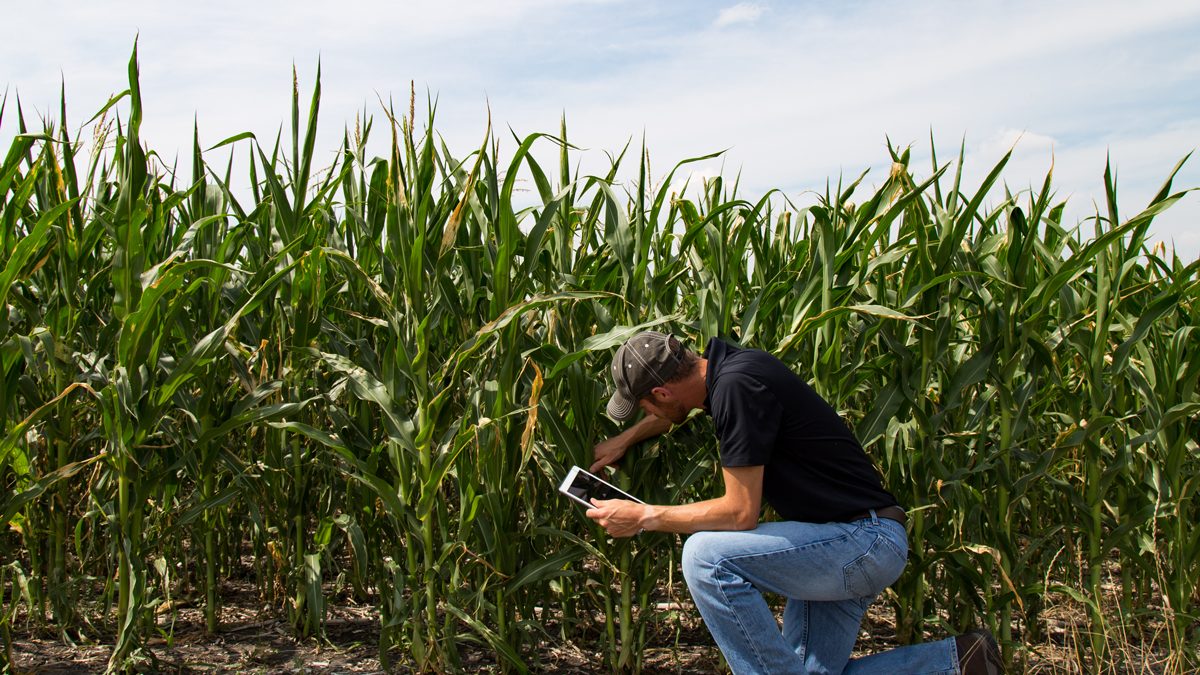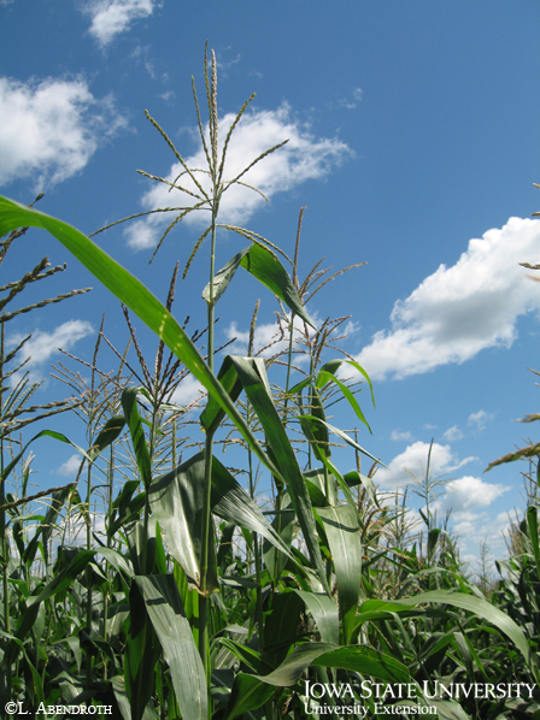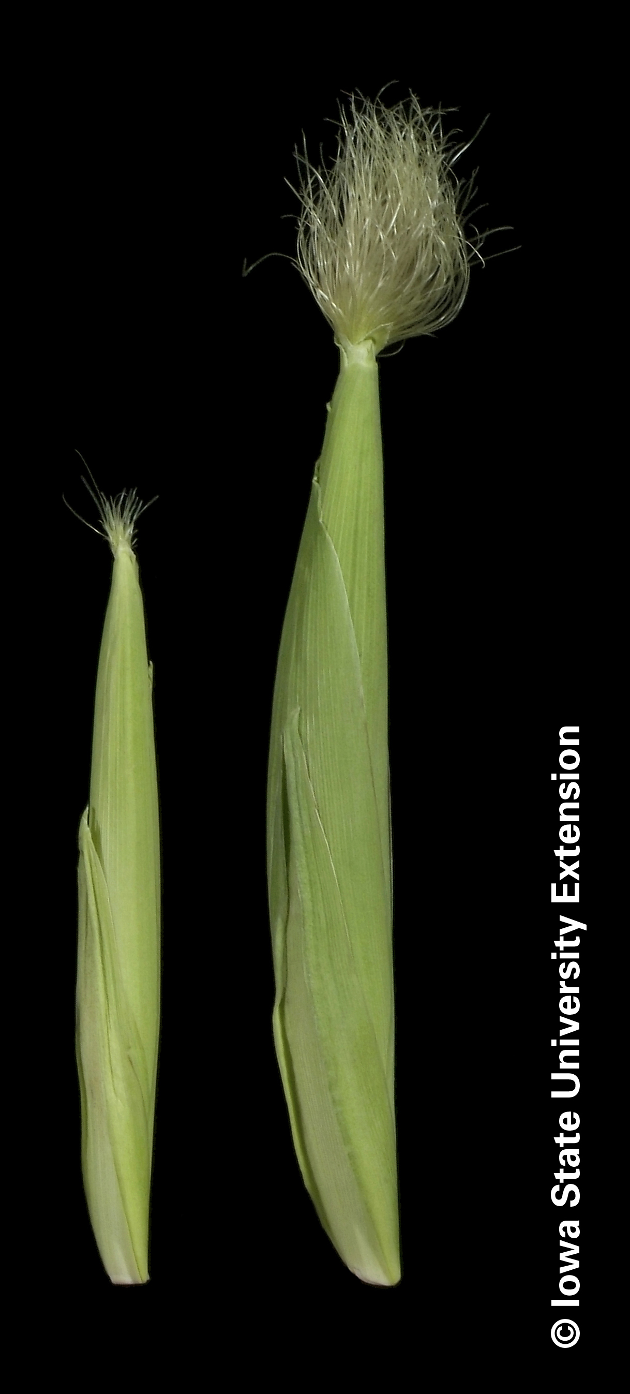Corn Growth Stage: V6 to R6 – Stalk Elongation to Tassel

In a previous post, we talked about what your corn is doing from germination to stage V5 and what you should be watching for. Today we’re going to visit the topic again and take it further into the plant’s growth during this corn growth stage.
Stalk Elongation to Tassel
V6 – Sixth Vegetative Leaf
What’s happening?
- Stems continue to elongate
- Root systems keep expanding
- Accelerating growth means an increase in nutrient uptake, the plant needs fuel for the growth spurt!
What to watch for:
- This is where your fertility program will be tested again. Limited nutrient availability will slow plant growth
- Goss’ Wilt – you might start seeing Goss show up alongside roads or after storms, watch for signs and make notes for future management. Check out our work on Goss’ Wilt here.
- Aggressive growth – lots of heat and aggressive growth might cause leaves to get caught up in the whorl or have bright white streaks. It’s ok! The plant is just growing too fast to keep up with itself. The leaves will straighten out and green up over a few days.
V7 – Seventh Vegetative Leaf
What’s happening?
- Tillers initiate from the lower nodes.
- Roots are reaching out beyond starter fertilizer.
What to watch for:
- Check your tillering. If there seems to be a lot of tillers, consider re-visiting your population and fertilizer plan. Extra resources in the soil allow corn plants to put on more tillers than normal.
- Side dressing: if side dressing fertilizer is part of your fertility plan, V6 to V8 is a good time to apply with minimal injury to roots and leaves.
V8 – Eighth Vegetative Leaf
What’s happening?
- Brace roots will be emerging near the soil surface
- The tassel begins more rapid growth within the whorl
What to watch for:
- Nutrients, nutrients, nutrients! Rescue applications can still be made, but higher clearance equipment may be needed to prevent damage.
V9 – Ninth Vegetative Leaf
What’s happening?
- Growth spurt! After V9 or V10 new leaves should be fully emerged every 2-3 days
- Elongation kicks into high gear and the plant can grow 1-2 inches per day.
What to watch for:
- Hot days and warm nights mean the plant won’t get a break, the stalk can be weak and spindly. Hot days with cool nights (50-60 degrees) are what you want to see.
- Want to see a cool experiment? Around this stage, walk out and spray paint the stalk of a corn plant. Come back the next day and see how much its grown! In the right conditions, it might surprise you!
V10 to V15
What’s happening?
- Dry matter accumulation ramps up. The number of GDU’s needed between leaves shortens, and collars will begin emerging more rapidly in good growing conditions.
- Roots are reaching up to 8 feet from the plant.
What to watch for:
- Nutrient and water deficiencies will have an impact on yield. Kernels per row are finalized during V10 to V17. This is where a lot of the harvestable yield is determined.
- Injury. While you can’t do much about hail, be scouting for insect damage. It can have a big impact during this critical period.
V16 to V(nth)
What’s happening?
- Late ‘teenager’ stages for your corn.
- Silks and tassels might be poking out slightly, though they are not viable yet.
- Depending on maturity, vegetative growth may be slowing or stopping entirely. The earliest of ND hybrids develop around 16 leaves.
What to watch for:
- Moisture, moisture, moisture! There is a four-week window surrounding silking that moisture will be the most important. Drought stress from V16 into R2 can cause up to 50% yield reduction! If you have irrigated corn, now is the time to watch those moisture levels.
VT (Tasseling)

What’s happening?
- Exciting stuff! VT starts a few days before the silks are viable. The last branch of the tassel will emerge from the shoot and pollen shed begins!
What to watch for:
- Again, moisture, moisture, moisture! Drought stress won’t delay pollen shed, but it WILL delay silking. If silks are delayed too long, they will miss the main pollen shed window.
- Hail – Again, not much you can do about hail, but hail damage to the tassel that prevents pollen drop will seriously limit grain formation.
R1 – Finally!

What’s happening?
- Silks are emerging! Fertilization is happening! Woo-hoo! Silks will usually keep emerging to be pollinated for 2 to 3 days.
- Pollen shed should be going on in full force! If you walk through your field, you might come out yellow and covered in pollen.
What to watch for:
- We’re going to keep beating this point into the ground. MOISTURE. Your yield loss at this stage from stress can be huge! If you have irrigation and it’s dry out there, use it!
R2 – Blister
What’s happening?
- About 2 weeks after silking, kernels are visible, white, and filled with a clear liquid. Silks have dried up.
- Water requirements are still high.
- Starch is beginning to build up in the kernels and seed fill is accelerating.
What to watch for:
- This is the tail end of peak water requirements. For about another week, you’ll want to monitor water availability.
R3 – Milk
What’s happening?
- Starch is accumulating and makes up about 20% of the kernel. Kernels are filled with a milky white fluid.
- Root growth is slow, coming to an end.
R4 – Dough
What’s happening?
- Seeds are still swollen but are a much darker yellow.
- Kernels are filled with a doughy material
R5 – Dent
What’s happening?
- Kernels are starting to dry down, making the signature dent on the back of the kernel.
- The milk line is now visible and will progress down the length of the kernels over the next few weeks.
R6 – Physiological Maturity (Black Layer)
What’s happening?
- Maximum kernel dry weight has been reached!
- The milk line has made it the length of the kernel, and a black to brown layer can be seen at the base of the kernels.
- Kernel moisture decreases by 0.5% or more per day, depending on conditions.
What to watch for:
- Harvest is coming! Grain will be at about 30% moisture when first reaching black layer.
- Keep an eye on your field conditions so you are ready for harvest. You don’t want to let corn stand for too long and run the risk of lodging and harvest loss.











